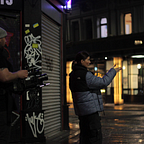Lost in Translation: An Exploration of Gender Roles With A Poignant Reminder Of The Importance Of Human Connection
Directed by Sofia Coppola, “Lost in Translation” is a captivating and introspective film that delicately explores themes of isolation, human connection, and the search for purpose. Released in 2003, the movie garnered critical acclaim for its nuanced performances, stunning cinematography, and evocative storytelling.
The film revolves around two characters, Bob Harris (Bill Murray) and Charlotte (Scarlett Johansson), who find themselves adrift in the bustling city of Tokyo. Bob, a washed-up actor, has come to Japan to shoot a whiskey commercial, while Charlotte accompanies her photographer husband on a business trip. As these two unlikely strangers cross paths in a foreign land, an unlikely bond forms between them.
One of the film’s greatest strengths is its ability to capture the essence of loneliness and disconnection in a foreign environment. Coppola masterfully juxtaposes the vibrant yet alienating nature of Tokyo against the characters’ internal struggles. Through her understated direction, the city becomes a character in itself, a backdrop to the emotional journey of Bob and Charlotte.
Bill Murray delivers a career-defining performance as Bob Harris. He impeccably portrays the weariness of a man caught in a mid-life crisis, searching for something meaningful amidst feelings of emptiness. Murray effortlessly combines his trademark dry wit with moments of profound vulnerability, creating a multifaceted character that is both relatable and endearing.
Scarlett Johansson, in one of her breakthrough roles, showcases her incredible talent as Charlotte. Her portrayal is subtle and introspective, allowing the audience to empathise with her character’s feelings of lost identity and purpose. Johansson’s chemistry with Murray is palpable, and their shared moments of companionship bring both levity and tenderness to the film.
The visuals capture the vastness and energy of Tokyo while also highlighting the intimacy of the characters’ experiences. The use of soft lighting and pastel colours adds a dream-like quality to the film, perfectly mirroring the ethereal nature of the story.
Coppola’s screenplay is poignant and thought-provoking. The dialogue is minimalistic yet rich in subtext, allowing the characters’ unspoken emotions to shine through. The film’s contemplative pace may not appeal to all viewers, but for those willing to delve into its introspective narrative, it rewards with a deeply resonant exploration of the human condition.
One aspect of “Lost in Translation” that aligns with feminist film theory is the examination of gender roles. The film portrays both its male and female characters as confined by societal expectations and the pressures of conformity. Coppola highlights the experiences of the film’s protagonist, Charlotte, a young woman trapped in a failing marriage and a state of existential uncertainty. Through her skilful direction, Coppola captures Charlotte’s journey of self-discovery, inviting the audience to explore the limitations placed upon women in society.
Furthermore, the film also delves into the concept of the male gaze, a prominent concept within feminist film theory. This theory posits that the camera, as an extension of the director, tends to objectify women and reinforce traditional power dynamics. Coppola subverts this gaze by showcasing moments where Charlotte reverses the power dynamic through her own acts of observation and contemplation.
By presenting her male characters, such as Bob Harris (played by Bill Murray), as lost and searching for meaning in their lives, the film challenges viewers to question traditional ideas of masculinity and the effects of that on the male characters. Additionally, the film explores the theme of female agency in a society that often diminishes and marginalises women.
Throughout the narrative, Charlotte grapples with her own identity and purpose. Coppola portrays her as a complex individual with her own desires, allowing the audience to empathise with her struggle and feel her frustration with societal expectations.
Coppola’s choice of setting, Tokyo, also contributes to the feminist undertones of the film. By placing the story in a foreign city with differing cultural norms, she emphasises the displacement experienced by the characters and draws attention to the ways in which gender expectations can vary across different cultures.
However, it is important to note that while “Lost in Translation” embraces feminist themes and perspectives, it does have limitations. Some critics argue that the film does not fully develop the female characters beyond their relationships with the male characters, which can be seen as reinforcing traditional gender dynamics. While the film does touch on these aspects, it could have delved deeper into the complexities and individualities of the female characters’ experiences.
The film also garnered attention regarding whether or not the film perpetuated stereotypes and exoticised Japanese culture. Sofia Coppola has stated that the film was based on her own experiences in Tokyo, and it reflects her own perspective and personal insights. Whilst some appreciate this exploration of cultural disconnection and individual experience, the interpretation of the films portrayal of race and culture is subjective and varies among different viewers.
Overall, “Lost in Translation” skilfully explores themes of gender roles, the male gaze, and female agency. Sofia Coppola’s direction provides a unique and nuanced perspective on these issues, provoking thoughtful reflection and discussion. Whether one agrees entirely with the film’s execution or not, it undeniably offers a compelling and introspective viewing experience, making it an essential entry into the realm of feminist cinema.
